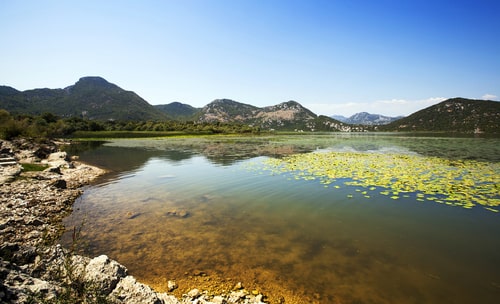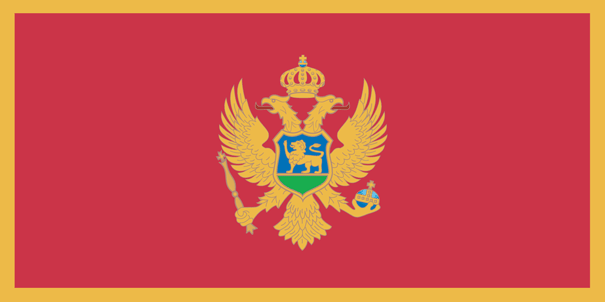Last updated on October 25th, 2022
Montenegro, officially the Republic of Montenegro, is a country in Southeast Europe on the Adriatic Sea. It has an area of 13,812 square km. Podgorica is its capital and largest city. Montenegrin is the national language of Montenegro. Euro is its official currency. Its land bordering countries are Croatia, Bosnia and Herzegovina, Serbia, Kosovo, Albania and the Adriatic Sea. Montenegro is a parliamentary republic with a President elected directly by the people who serves as the head of state. The economy of Montenegro is heavily dependent on services followed by industry and agriculture.
History and Geography
1. Montenegro declared its independence from Serbia on June 3, 2006.
2. Montenegro got its name from the dark mountain forests that cover the land. The name breaks down into two words, ‘monte’ and ‘negro’ (black, mountain), and dates back to the 15th century.

3. Lake Skadar is the largest in the Balkan region, with two-thirds lying in Montenegro and the remainder in Albania. The freshwater lake is refuge to over 270 bird species (a large number of them migratory birds). Apart from the majestic Dalmatian Pelicans, other species of note include herons, ibises, egrets, falcons, storks and pygmy cormorants. And a little way along the coast, one will come across the Ulcinjska Salinas, an old salt works where you can get to watch 40,000 birds at a time—and not the least among them large flocks of stately pink flamingos!
4. When it comes to diverse architectural as well as cultural heritage, it is difficult to parallel the rich heritage of the ancient coastal town of Ulcinj, the southernmost Montenegrin town. Having been under several different rulers down the centuries (among them, Roman, Byzantine, Venetian and Ottoman), the architecture of the town makes for a wonderful potpourri of various styles. On the cultural side, too, the town shows a strong Middle Eastern influence due largely to its physical proximity to Albania.
5. In area, Montenegro is comparable to the size of Connecticut.
6. Montenegro is a small country with a population of less than one million people (644,578 (July 2016 est.)). However, the country shows major economic potential, especially from its tourism industry.
7. The country has 117 beaches along the Adriatic coast.
8. Ulcinj is also home to the longest beach on the Adriatic Sea. Aptly named Velika Plaza (‘Long Beach’), this 13 km long sandy beach also featured in the New York Times’ 2010 list of top travel destinations around the world.
Map of Montenegro
9. Montenegro is a famous tourist destination. The legendary English romantic poet Lord Bryon once described the country this way: ‘At the birth of the planet the most beautiful encounter between land and sea must have been on the Montenegrin coast’. This is a testament to the country’s striking beauty, which is no doubt one of the primary reasons why it attracts millions of visitors.
10. Podgorica is the capital and largest city of the country. It covers a total area of 55.6 square miles. The city hosts Montenegro’s administrative, economic, cultural and educational centers.
11. Montenegro’s capital city, Podgorica, would perhaps be better known to many of today’s generations as Titograd. Since that’s the name the city had had for itself for almost half a century—from 1946 to 1992, in honor of the scandalously famous socialist leader Josip Briz Tito. Fortunately, however, it recovered its old name (the one that was first recorded way back in the 14th century and has since withstood practically any number of invasions) once the socialist block crumbled.
12. Podgorica is famous for its sun, thriving coffee culture, but also for its impressive number of uniquely-themed churches—and there is one exclusively meant for fans of Brutalism!
13. The country’s flag features a golden lion. The flag is based on the flag that was in use during the reign of King Nicola I, who was king between 1910 and 1918.
Flag of Montenegro

14. The Tara (Drina) River in Montenegro is known for its clean water. The total length is 144 km, of which 110 km are in Montenegro, while the final 34 km are in Bosnia and Herzegovina; it also forms the border between the two countries in several places.

15. About 60% of the country is more than 1000 meters above sea level, with the tallest peak – Bobotov Kuk in the Durmitor Mountains – at 2,522 meters.
16. ‘The City of the Sun’ and ‘The Town of 100,001 Steps’—these are the two prime sobriquets attached to Herceg Novi, another breathtakingly beautiful coastal town of Montenegro. The first refers to the bright and sunny tropical climate of the place which is responsible for the rich variety of tropical flowers, but especially mimosas, the town is famous for. The second moniker owes its existence to the Old Town of Herceg Novi with its numerous flights of stairs that strand countless buildings and fortresses dating back to 14th-16th centuries.
Tourism and Trade in Montenegro
17. The country has a diverse population. Native Montenegrins make up about 45% of its population while Serbs, Bosniaks, Albanians, Muslims and Croats form the rest of the country’s population.
18. Serbia, Italy, Germany, Croatia, and Hungary are its major trade partners.
19. Tourism, steel making, aluminum and food processing represent its major industries. Handmade carpets, wood carvings, tapestries, ceramics, filigree jewelry, ceramics, art and wine are some of the famous items from the region that you can buy while in Montenegro.
20. The World Tourism and Travel Council (WTTC) placed Montenegro first on its list of countries where tourism is a strategic industry. Tourism in the country is expected to grow at a rate of 8.8 percent over the next ten years. Are you looking to visit a new place? Why not Montenegro? You can also enjoy winter snow sports such as skiing and snowboarding, as well as other sports including climbing, white-water rafting, scuba diving and many more.
21. Crvena Stijena by the village Petrovici near Niksic is one of Montenegro’s oldest cultural and historical monuments. The cave is unique in the world because of the numerous cultural artifacts it contains.
22. The town of Niksic is also home to two impressive feats of human architecture/construction. The famous Tsar’s Bridge or the Carev Most (269 meters long and consisting of as many as 18 arches) on the Zeta River and the artificial Lake Krupac— or the “sea”, as it is referred to by the Niksic locals.
23. Sveti Stefan is certainly one of the tourist icons of Montenegro. What is lesser known, though, is the fact that Marilyn Monroe’s favorite getaway destination in Europe used to be Sveti Stefan, an islet on the Budva Riviera. It is located just 15 minutes from Budva, by car. Aman Sveti Stefan, a luxury holiday resort on the island, had more than once enjoyed the privilege of playing host to the iconic Hollywood actress. (Although when Monroe visited it in the 50s, the luxury hotel was not owned by the Aman chain. Other past celebrities of significance have paid visit to the resort? Sophia Loren, Princess Margaret, Liz Taylor, Orson Welles…and so goes the list!)

24. The monastery of Ostrog, located above the Bjelopavlic valley, is one of the most visited shrines in the Christian world. It is carved in rocks and was founded in the 17th century by Saint Basil.
25. Montenegrins celebrate their national holiday on July 13, which is also known as Statehood Day. They celebrate this day to commemorate the day that Montenegro was recognized as the 27th independent state in the world by the Berlin Congress, which occurred on July 13, 1878.
26. Montenegro winters are cold, snowy and intolerable. This is the reason why the country sees a drop in tourism during these months.
27. Almost all Montenegrin coastal towns boast of well-preserved Old Towns full of fantastic histories, legends, and countless artefacts and treasures from antiquities. And of all these old towns, perhaps the most famous is the Old Town of Bar. More than 2,500 years old, the frescoes, bas-reliefs, tumbledown walls of the many fortresses and the like make a walk across the old town a magical, almost fairytale-like experience. Stop by the archaeological museum of the town and you’ll get to have a look at extraordinarily beautiful murano glass ceramic vessels from 6-8 centuries BC or mosaic fragments dating back to 5th-6th century AD.
28. However, the old town of Bar is perhaps more famous for being home to Stara Maslina, one of the oldest known olive tree in the world. The 2000-years old tree is found inside an equally impressive and massive olive grove housing over 100,000 olive trees!
29. Mausoleum of Peter II Petrovic Njegos—officially the highest mausoleum in the world–-is located some 13 kms away from the historic city of Cetinje. Seating at a height of 1,660 meters on the Jezerski Peak, this mystic site offers a stunning view of the surrounding Lovcen Mountains. The vault of the mausoleum is decorated with 18 kilograms of gold and the two stone caryatides found on the mausoleum lobby are believed to be those of Njegos’ mother and daughter.
Montenegro in Hollywood Movies
30. Montenegro is featured in the movie “Casino Royale,” released in 2006, starring Daniel Craig as James Bond. And Brad Pitt started his Hollywood career when he acted in a movie filmed in the country in 1987.
Native People and Culture
31. Family life and values as well as clan and tribal identities are things that are highly regarded in Montenegro. This accounts for the importance of religious festivals and celebrations but also for the colorful cultural life of the nation and its people that is steeped in traditional dance, music, poems, epic songs and the like. And you’ll get to sense (and revel in) this spirit of intimacy and general bonhomie at pretty much all Montenegrin towns and cities.
32. Montenegrins have their own unique weltanschauung by which to live life. And this is amply illustrated in several typical Montenegrin proverbs.
Samples:
1. Love thy bed as you love thy own self.
2. If at any time you are gripped by a strong urge to work, sit down, be quiet, wait, and in due course it will pass.
You can probably already guess they will not be a difficult people to get along with!
33. Finally, once at Montenegro, one should by all means accustom himself to feeling small. Since Montenegrins, according to one reliable source, are the second tallest people (next only to the Dutch) in the earth. Average height of a Montenegrin man is 1.832m!
Continue reading on the next page…
